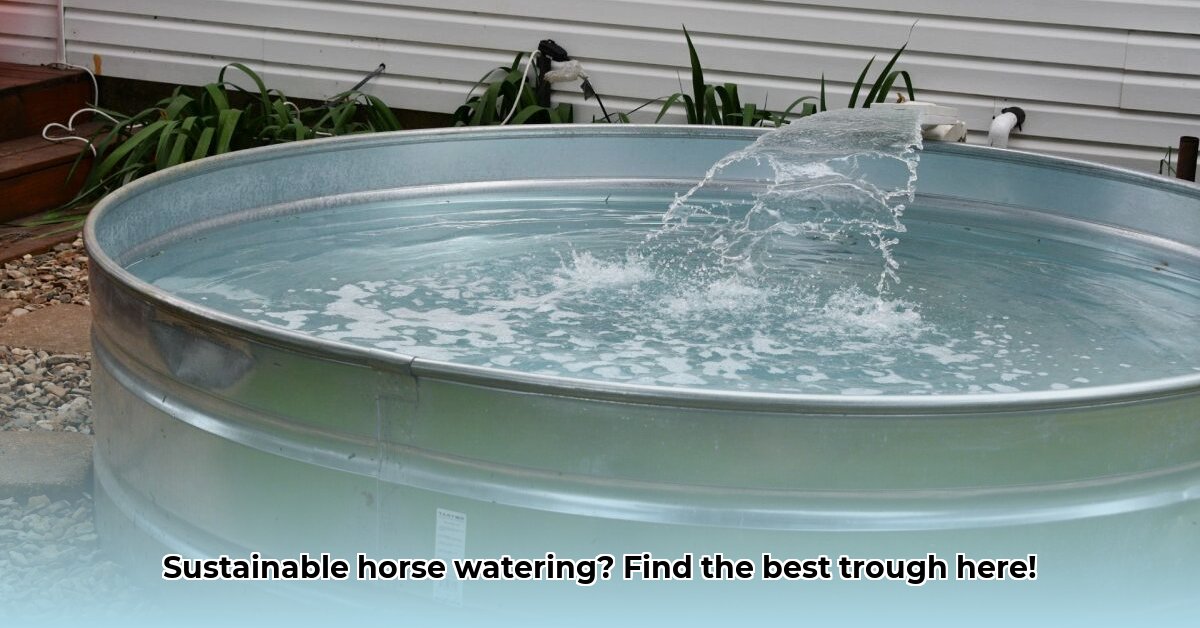
Finding the ideal horse water trough is crucial for your equine companions' well-being and your farm's sustainability. This guide helps you navigate the choices at Tractor Supply, focusing on durability, efficiency, and eco-conscious practices. For more equine supplies, check out Tractor Supply Horse Toys.
Choosing the Right Material: Durability and Environmental Impact
The trough's material significantly impacts its lifespan and environmental footprint. High-quality steel troughs, while initially pricier, offer superior durability, often lasting for years, reducing replacements and waste. This longevity translates to long-term cost savings and minimizes environmental impact compared to more frequent replacements of less durable materials. Think of it like investing in quality work boots—an upfront cost that pays off with years of reliable service.
Plastic troughs, while initially cheaper, suffer from shorter lifespans due to UV degradation and potential cracking. This necessitates frequent replacements, increasing costs and waste. While lightweight and easy to move, the recurring expenses and environmental burden associated with their shorter lifespan should be factored into your decision. Are the initial savings truly worth the repeated purchases and environmental impact?
Sizing Your Trough: Meeting Your Herd's Needs
Selecting the correct size is vital for preventing water shortages and competition among your horses. An undersized trough leads to frequent refills, wasting water and time. Conversely, an oversized trough can lead to unnecessary water storage and potential issues with water quality if not regularly cleaned and maintained.
Consider your herd size and each horse's average daily water intake. Tractor Supply offers troughs in various sizes to accommodate different herd sizes. Prioritize a trough that allows all horses to access fresh water simultaneously, minimizing competition and stress. A properly sized trough might seem more expensive initially, but its efficiency and reduced water waste outweigh the increased upfront cost.
Enhancing Efficiency and Sustainability: Advanced Features
Beyond the basics, consider these features to optimize water management and reduce your farm's environmental impact:
Automatic Fillers: These automated systems maintain optimal water levels, saving time and preventing water waste from manual refills. Automatic fillers are a simple yet effective way to improve water management.
Elevated Designs: Elevated troughs help keep the water cleaner by reducing mud and dirt contamination, minimizing cleaning and ensuring better water quality for your horses. An elevated design is a simple addition that can significantly impact water hygiene.
Covers: Covers prevent debris from contaminating the water, reducing cleaning frequency. They also help minimize water evaporation, conserving water resources over time. A cover can improve water quality and significantly reduce water waste.
Sustainable Practices: A Responsible Approach to Horse Care
Sustainable farming extends beyond individual practices. Choosing a durable trough contributes to long-term sustainability by reducing waste and conserving resources. Dr. Emily Carter, Professor of Environmental Engineering at Cornell University, emphasizes, "Sustainable agricultural practices are not just about environmental responsibility; they also contribute to long-term economic viability and improved animal welfare." This holistic approach optimizes your farm's efficiency and minimizes its environmental footprint. It's an investment in your future and the environment.
Material Comparison: A Decision-Making Framework
The table below summarizes the pros and cons of common materials, assisting you in your decision-making process, based on your individual needs and budget.
| Material | Pros | Cons |
|---|---|---|
| High-Quality Steel | Extremely durable; long lifespan; resists damage; maintains temp | Higher initial cost; requires regular maintenance to prevent rusting |
| Polyethylene | Lightweight; inexpensive; easy to clean | Less durable; prone to UV degradation; doesn't regulate temperature well |
Remember, the best choice balances your budget, your horses' needs, and your commitment to environmental stewardship. A durable trough, while potentially more expensive upfront, will save you money and reduce environmental impact in the long run.
Choosing Your Trough: A Step-by-Step Guide
- Assess Your Needs: Determine the number of horses, their water consumption, and your farm's climate.
- Consider the Materials: Evaluate the pros and cons of steel and plastic, factoring in durability, maintenance, and cost.
- Select the Right Size: Ensure the trough accommodates your herd without leading to water shortages or unnecessary waste.
- Explore Additional Features: Consider automatic fillers, elevated designs, and covers to maximize efficiency and sustainability.
- Prioritize Durability: Invest in a quality trough to reduce replacements and minimize your environmental footprint.
By following these steps, you can confidently choose a horse water trough that perfectly balances your horses' needs with your farm's sustainability goals. Remember, this decision extends beyond immediate cost; it's an investment in the long-term well-being of your horses and the health of our planet.